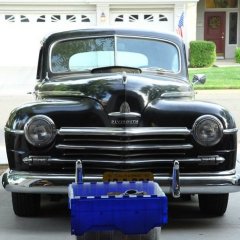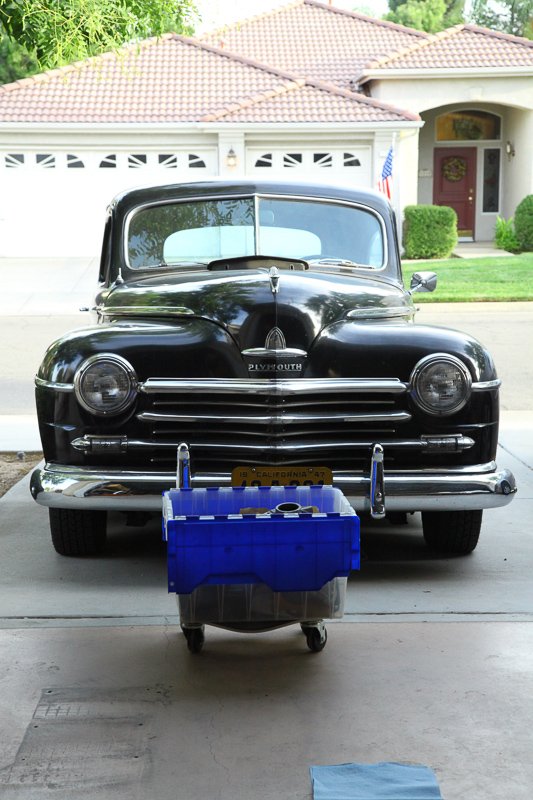-
Posts
289 -
Joined
-
Last visited
-
Days Won
2
Content Type
Links Directory
Profiles
Articles
Forums
Downloads
Store
Gallery
Blogs
Events
Classifieds
Everything posted by Mark Haymond
-
I put in a Champion radiator. The fins are very soft so protect the front and back of the radiator with cardboard or sheet metal during installation. It only takes a few oops moments with knuckles or tools to put ugly dings in the fins. This is only cosmetics, it will not hurt the radiator. But you will be happier every time you open your hood.
-
Kiethb7 maybe the Town and Country owner expected you to be one more guy to look for a chromed dressed big block under the hood and be disappointed.
-
That is funny. Someone was careless at work, no doubt.
-

Distributor shaft to engine block gasket?
Mark Haymond replied to thebeebe5's topic in P15-D24 Forum
My 50 Plymouth had a cork gasket. The gasket will not be under air pressure. It is used to keep oil that swirls up the shaft from leaking out under the distributor. -
My 50 Plym plastic gear shift knob was missing. I found that the similar plastic cowl vent knob from a wrecking yard fit perfectly and was very similar in appearance. The threads are a standard SAE coarse size. I am suggesting that many knobs with the same thread size could be used. If it is the wrong color, paint it.
-
I will say this in jest but other owners who have done it may agree in spirit. Carefully list the dollar cost of all your drivetrain upgrade parts. Multiply by three. Calculate the number of weeks for the complete upgrade project. Multiply that by ten.
-
A dual reservoir master cylinder and disk brakes will be a big safety improvement. You can take your time to decide all the other stuff, according to your own schedule, fabrication skills, and budget.
-
If the glass is too big because the shop traced around your blanks and cut on the wider traced line the glass may not fit. That happened to me.
-
My gray 50 Plymouth had black welting on the rear fenders. I think I got replacement welting from Andy Berbaum but that was 15 years ago. It was a little tricky getting it in straight during the fender tightening but it looked good at the end. I had the car painted first and put in the black welting afterward.
-
Clickbait. I should have known better. I just wasted three perfectly good groans from my lifetime allotment.
-

P15 dash install / rattle prevention tips / help
Mark Haymond replied to 3046moparcoupe's topic in P15-D24 Forum
On my P15 there were some anti rattle cloth type strips between the sides of the dash and the side of the frame near the door openings. I may have reused them, I don't remember. I don't have any dash rattles, I think the strips were a little bit of "good practices" overkill. The purpose of the piping under the front of the window garnish may have been to prevent air leaks from the defroster channels in the garnish. -
I have a 50 Plymouth Special Deluxe with a heater. The heater core was moved to the engine compartment about 49 to prevent a dangerous core failure next to the front passenger's feet. The Special Deluxe had a second blower motor under the dash to drive the defroster vents. The old heater worked well for me when the temps were below 32 degrees in Western Maryland. I did not have to run it on "high" to be warm. The repo duct should work fine, the originals were some kind of pressed and stapled fiber material. After all, it is just an air duct, so any fiber or metal duct should work if you do not need an original look. Make sure to keep the duct sealed well at the firewall or you may get carb smells.
-

Update on the 1947 Deluxe and some questions!
Mark Haymond replied to Mortimer452's topic in P15-D24 Forum
It is not unusual for a water pump seal to fail after a car has not run in years. These engines were used for cars, trucks, agricultural equipment, and forklifts. So you can probably get one at NAPA or your local store. Get a pump, don't bother with a repair kit. -
That is a good looking Meadowbrook, a good example of a 1950. Don't try too hard to fix the fuel evaporation because it is a common symptom and they all tend to do that to a certain extent. Oh sure, you can get a six volt fuel pump, and it is a good idea to install a tip-over or collision switch so it stops pumping after a collision. This info can be found with a forum search. OR, you can do NOTHING about it. You will have a few extra seconds of cranking the first time you start it after a week. Can you live with that? The car will start reliably like this for decades to come.
-

P15 Motor Serial Used for VIN vs Body Number - DMV Screw Up?
Mark Haymond replied to fedoragent's topic in P15-D24 Forum
It ain't broke so don't fix it. I am in California. Yep, they used the P15 engine serial number for registration back then. My local CHP understood this when I took mine in to get it registered and safety inspected so don't assume they are all dumb and you are going to get the run around. I think you are in a good position, you really don't have to change anything. Your have all matching numbers on your vehicle which is pretty cool. -
I had the 217 flathead rebuilt when I restored my 1950 Plymouth in 1998. I have driven it as a hobby car mostly around town, but with some occasional 200 or 300 mile round trips. I even drove it every day to work for a year. Over the past 16,000 miles I have done some maintenance and garage repairs like most owners, but it always brought me home on its own power and I never needed a tow. I feel this engine would take me anywhere. It is in stock condition, with generator, four blade fan, distributor, mechanical fuel pump, partial flow oil filter and other stock stuff. Reliable, not fragile.
-
I had a leak from the fuel sender gasket on top of the tank after filling up all the way. The overflow came down and dripped off the low parts of the tank. ..... I also have experienced a leak from the drain plug after fooling with it. After trying all sorts of things to tighten it I found, as DonaldSmith suggests, that a square 1/2 inch drive fit those funny corners perfectly.
-
While running new wires, run some extra wires from the dash area to the trunk, in case you want to install sound speakers in the package tray under the rear window. Or you can use them for other future accessories.
-
I also got the U joint from a kit, a Fat Man Fabrications Cavalier kit. Unfortunately the part number is not listed, it is simply called a "Borgeson U joint" in the instructions. One end fit the square actuator of the rack, the other end fit the diameter of the stock steering shaft perfectly. I saved a little exhaust header clearance space by cutting off the outside steering column tube about half way down the engine column. I did not want to weld the U joint to the steering shaft, so I drilled and pressed in a split pin to back up the set screws on the shaft side of the joint. My steering column had to tilt at a steeper angle but I got the arm length and tilt to suit me. The stock steering wheel keeps the stock look. A Lokar "nostalgia" floor shifter for my 904 tranny with chrome lever and simple black knob looks stock to the casual viewer.
-
With my 46 Plymouth and Cavalier rack, my stock steering shaft would clear the headers, run straight down to the square input of the rack and connect with a single universal connector. (But my engine is a 318. Yours may be too wide.) A local tractor and Ag service place made up a Cavalier high pressure tube to Mopar power steering pump line and it did not cost much at all.
-
With winter coming on, consider the mess and panic experience of a leaking or burst heater core inside the car. Mine happened in a Starbucks drive through, third in line with no way to escape. It quickly steamed up the windows and leaked heavily on the floor and then out the door. I routed one of the heater hoses in a short circuit loop back to the engine as a roadside repair. Maybe the price of a new core would be worth the peace of mind.
-
I hope you just need a new battery. Batteries are fickle. Last week I started my Plymouth in the garage. Baam it fired up strong as usual. I drove to the store and bought a load of groceries and put them in the trunk. Baam it started right up. I stopped again at the ATM at the bank. Baam it started right up. I drove around to the other side of the bank and got ready to pull into traffic. Sensing there was a small line of cars behind me, the engine died. (lack of ignition power) The starter relay just clicked feebly, the horn was feeble, headlights were dim, you know the story. I called my wife to come and save the groceries because it was a warm day. For the first time in ten years I used my AAA card. The driver did a quick charge on the battery and followed me home a mile and a half away to make sure I made it. Back at the house my three year old battery only had 10.7 volts so I guess a cell shorted or failed. With your automotive experience I am confident you will get to the bottom of the problem quickly without our help, so I am just sharing my story for fun and grins.
-
...These cars drove on many rural lanes and dirt roads in the forties when it was good to have ground clearance. They sat higher than today's cars. When I still weighed 150 I could squeeze under the frame to work on the transmission or driveshaft of my P15 Plymouth. ...I can't tell if your car is too high from your photo. Maybe we can get someone to measure their car, from the ground to the bottom of the frame and you can compare that height to yours.
-
McDonalds, a few years ago. Dad and a ten year old boy look briefly at my Plymouth outside before coming in and they sit in the booth next me. Dad, "It's probably a 55." Son, "No it's a 50." Dad, surprised, "How would you know that?" Son, "It says 1950 on the license plate frame."


